No CrossRef data available.
Published online by Cambridge University Press: 15 March 2011

page 193 note 1 There is a short notice of Ibn Jubair in Professor Browne's valuable “Literary History of Persia,” ii, p. 483Google Scholar, though it is hard to see why a book written in Arabic by a Spaniard should be mentioned there, or why Nāẓir ![]() who came from near Balkh, should be included, and Amīr
who came from near Balkh, should be included, and Amīr ![]() whose father came from Balkh, be excluded. Balkh is in what used to be called Khūrāsān, but Qubāzīān, where Nāẓir
whose father came from Balkh, be excluded. Balkh is in what used to be called Khūrāsān, but Qubāzīān, where Nāẓir ![]() was born, is north of the Oxus, and so belongs to Transoxiana.
was born, is north of the Oxus, and so belongs to Transoxiana.
page 194 note 1 The story bears a resemblance to one told by Nāẓir ![]() of himself (Browne's, “Literary History of Persia,” ii, p. 221). His travels took place about 150 years before Ibn Jubair's.Google Scholar
of himself (Browne's, “Literary History of Persia,” ii, p. 221). His travels took place about 150 years before Ibn Jubair's.Google Scholar
page 194 note 2 The translator says in a note that Ibn Jubair places the temple at the west of the town, but in the text of the translation, p. 31, it is placed at the east. It is also east in the Arabic.
page 197 note 1 See his “Bib. Arabo-Sicula,” i, chap, x, p. 137, Turin and Rome, 1880, and Journal Asiatique for 1845, and especially the valuable notes at p. 208 of id. for March, 1846. The Arabic is in a vol. of the Bib. A.-S. published at Leipzic in 1857.Google Scholar